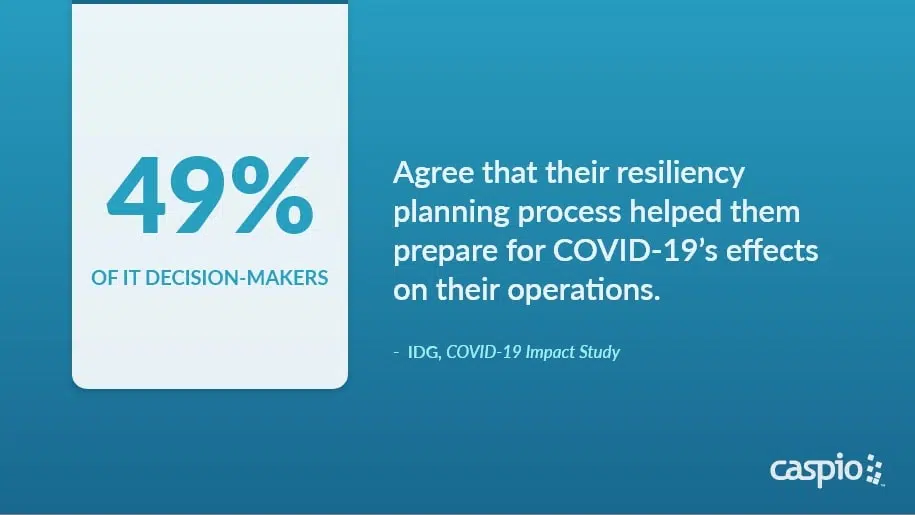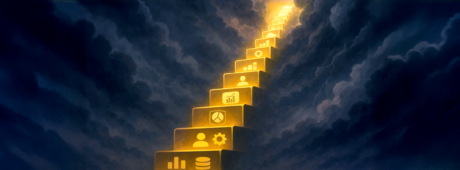How COVID-19 Changed the Role of CIOs
November 9, 2020

At the start of 2020, technology initiatives were beaming with possibilities.
Almost 60% of IT leaders expected their budgets to increase over the next 12 months, with only 7% anticipating a budget decline. Two months later, the coronavirus pandemic emerged and life as we know it changed — along with business priorities. New processes, urgent demands from customers and stakeholders, and economic uncertainty sent even the most capable companies into disarray.
At the center of this chaos is the CIO, who now has to transition from safeguarding company data to trailblazing business recovery.
Are CIOs and IT leaders stepping up to the plate?
Changing Landscapes, Shifting Priorities

According to the 2020 State of the CIO report released by IDG at the start of the year, CIOs were supposed to focus on enhancing security management, aligning IT initiatives with business goals, and implementing new systems and architectures.
The pandemic turned everything upside down.
An unprecedented number of employees began working remotely, and companies started facing challenges ushered in by the “new normal.” As a result, CIOs are now spending more time on a new set of priorities. Security management now sits far down on their list, overshadowed by cost control, IT operations improvement, business process redesign, and strategy development and refinement.
And so, the role of CIOs is evolving.
4 Areas Shaping the New Role of CIOs
Chief Information Officers are focusing their time and energy on responding to new business challenges brought by the pandemic, specifically in these areas:
Remote Work Arrangement
Remote work previously seemed like a privilege for employees — not anymore. From about 3% in January, the percentage of employees working remotely skyrocketed to 64% by April, according to an SHRM survey.
IT teams went from supporting a small number of employees occasionally working from home to suddenly migrating the entire organization to the cloud. That’s a challenge at an entirely different scale. CIOs had to provide employees with secure access to company data, which is sometimes accessible only through on-premises infrastructure. Many adopted a cloud-first policy and expedited data migration efforts to ensure information accessibility and business continuity.
Cost Efficiency

According to Deloitte, the likelihood of implementing cost-reduction initiatives increased globally to 74% from only 46% pre-pandemic. About 66% of companies will now try to cut costs within the next 12 months, including technology expenditures.
As a result, CIOs must perform their typical responsibilities alongside new challenges while working with a dwindling budget. IT leaders now have to be smarter with how they use their funds by de-prioritizing useful but non-critical projects and leveraging systems that boost the IT department’s capabilities without increasing overhead.
Data Security
Now is not the time to delay security initiatives.
Security management is no longer the principal focus of CIOs, but it remains a priority, especially today, when most companies have transitioned to a more flexible work setup.
Since employees are working in a remote environment instead of a controlled corporate network, they are more vulnerable to cybersecurity risks, such as data hacking and phishing.
CIOs must be more critical in evaluating new cloud tools and the security and compliance features these tools provide. They must safeguard organizational data — as they always have — while making it more accessible via the cloud to employees who need it to get their job done.
Resiliency Planning

According to IDG’s COVID-19 Impact Study, 49% of IT decision-makers said their resiliency planning process helped them prepare for the current situation.
Now more than ever, CIOs need to spearhead digital transformation efforts to ensure business continuity and resiliency. They must build new processes and fine-tune existing ones to address ever-changing requirements in the new normal, and even post-pandemic.
On a larger scale, organizations must adopt cloud technologies to replace slow, outdated legacy systems that significantly impact overall agility and productivity. Cloud solutions, especially no-code and low-code development, allow businesses to bounce back from the pandemic and achieve digital transformation faster.
Low-Code Transformation in the New Normal
No-code and low-code development acts as a catalyst for change, providing CIOs with the tools to accelerate digital transformation within their organization amidst the pandemic. By allowing both IT and business professionals to build custom applications without hand-coding, CIOs simplify processes, bridge departmental silos and improve collaboration with minimized risks.
Our research found that most IT leaders consider no-code and low-code development as powerful tools to fulfill the demand for custom applications. Low-code users are more likely to deliver apps on time, scope and budget than those who do not use low code.

No code and low code enable CIOs to secure organizational data while empowering business professionals to build applications on their own — without straining the IT team or hiring additional personnel.
As a result, the business gains the digital tools it needs to remain resilient, even under duress.
J-W Power, which operates the biggest privately owned natural gas compression fleet in the U.S., used Caspio to meet the demand for internal applications amid an industry recession.
Despite not having enough IT staff to create custom applications, they built their first app with Caspio in just a month and quickly followed that with 15 other digital tools within six months. Many more are in the works.
Applications Manager Paul Woolsey and his team took advantage of robust Caspio features, including SAML single sign-on, Box integration, Triggered Actions and Scheduled Tasks, to further speed up their app development process. He also created a data warehouse within Caspio that allows his team to reuse master-level data from one system to another.
Caspio hit all the sweet spots. While it is intended for business users, it allows you to inject code. It’s the best of both worlds.
Paul Woolsey
Applications Manager
J-W Power Company
Jumpstart Business Recovery With Caspio
When asked by Deloitte about the defining characteristics of successful technology leaders today, almost 70% of C-suite and board executives used the words “change,” “innovative” and “vision.”
Be an agent of change, vision and innovation in your organization in these trying times. Use Caspio’s no-code platform.
Here’s how you can safeguard data while initiating business agility, recovery and cost-efficiency with Caspio:
- Easy-to-use platform – Empower non-technical users to build their applications without dealing with code. Caspio replaces traditional hand-coding with a guided point-and-click development process.
- Scalable cloud database – Migrate existing spreadsheets and file repositories into an online database that centralizes multiple sources, simplifies information access for remote work employees, shows updates in real-time and scales as your data grows.
- Security and compliance – Take advantage of enterprise-grade security for your apps. Caspio runs on AWS and SQL, and provides the strict security and compliance required by IT departments worldwide.
- Rapid development results – Create complex web apps within just hours or days instead of weeks and months. Build simple apps in around 10 minutes!
Ready to jumpstart recovery within your organization?
Schedule a free project consultation with a Caspio specialist and discover how you can use no-code development to position your business for success.
















